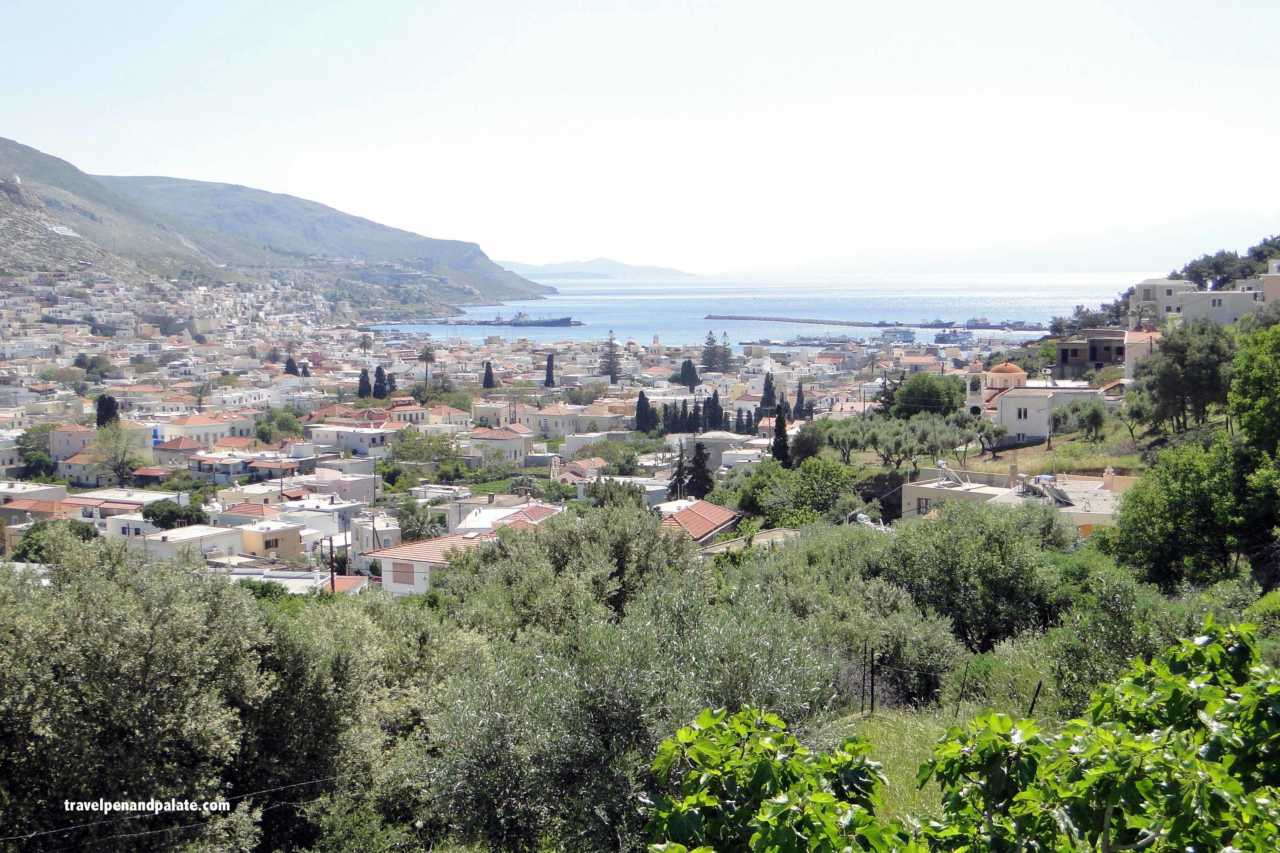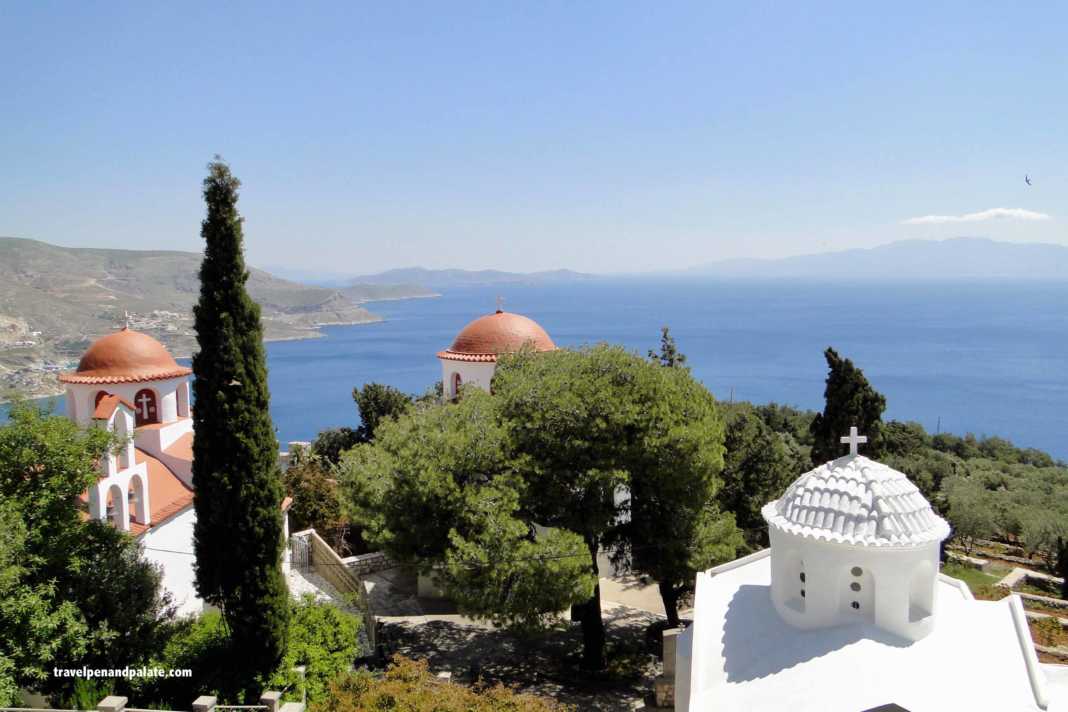From high atop St. Savvas Monastery the lush agricultural Pothia Valley is like green parkland bisecting this rocky land of Kalymnos Island. Groves of olives, fruits, grapes, dairy cattle, goats and vegetables thrive. What’s available from the surrounding Aegean is legendary.

Agronomist Giannis Karamalis said 20% of the permanent population of 12,000 was involved in agriculture. The volcanic soil loose with silica is ideal for grapes. Guava and other fruit trees have been found to do well and are gaining in popularity on the island. At one time truffles were abundant but unfortunately have disappeared.
Like many Greek islands, there’s not an abundance of rainfall. For the vineyards that dryness concentrates the sugar and intensifies the flavors of grapes, producing sweet wines. The best are made from sun-dried grapes producing a brandy-like after dinner wine.
Winery Coursiotis

Mr. George Koursiotis’ compact winery has vines of wild flowers draped over timeless stonewalls. The grape arbor shades the terrace of the ageless farmhouse as we sip Winery Coursiotis deep sweet red. It was a 19th century postcard scene.
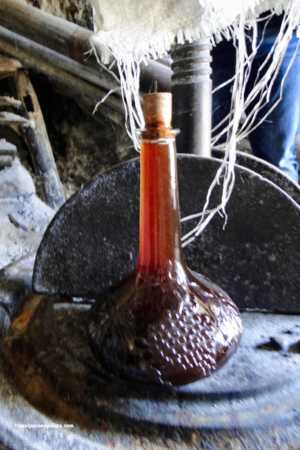
The vineyard seemed almost unkempt. George believes in organic natural growth agriculture. The grape vine vied with orange and mandarin trees.
Winery Coursiotis is for locals and produces the sweet wine preferred for Orthodox communion. Aging is on-site in natural caves that are wine cooler perfect providing even more 19th century atmosphere. The wine is unfiltered enhancing the intense depth of concentrated ripe Fokiano and Moshato grapes.

Beekeeper Mr. George Koursiotis
Many vineyards on the islands keep bees. Mr. Koursiotis’ beehives lay on the edge of a wild flower and herb-speckled field.

Given a choice Greek bees prefer thyme. Kalymnos honey is 70% from thyme flowers, but Mr. Koursiotis’ has tested at 90%. Other islands and regions, such as Crete, average 50%.
Having tasted many varieties of Greek honeys and thyme’s in particular, George is not boasting about the intense flavor of his honey. As bees wonder what we’re doing he deftly drips some on my hand fresh from the comb. I can see and taste why the gods appointed honey the official sweetener for Mt. Olympus.
Poppy’s Taverna, Vathy
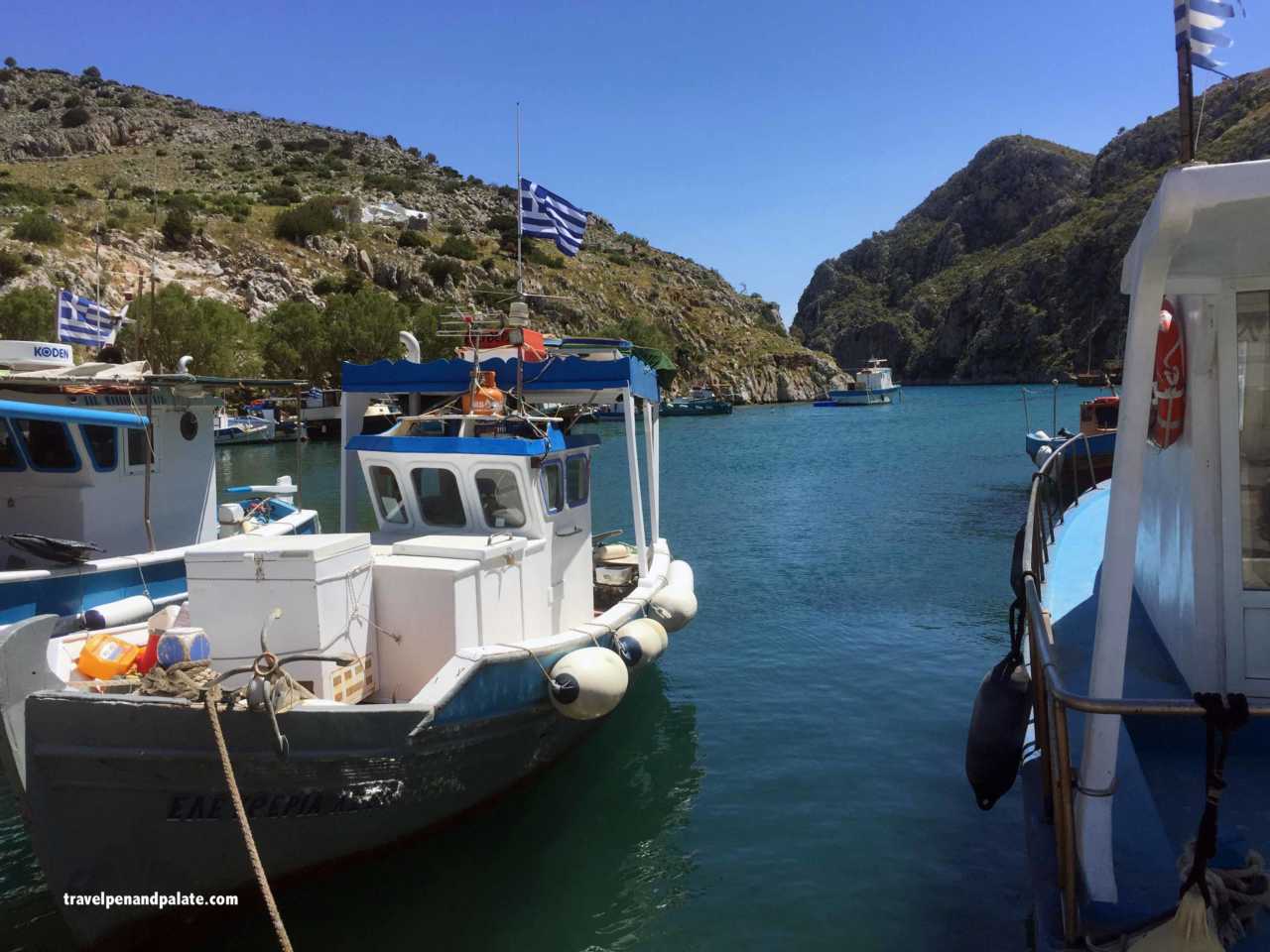
Vathy fijord is located in southern Kalymnos five kilometers from Pothia. With the protection of its dramatic cliffs, Vathy is a reminder that the Aegean Sea is still an economic engine for Kalymnos Island. The cliffs and caves made it popular with pirates and smugglers in the past.
Today the village’s serene coastal views, beaches and many traditional taverns make it equally popular with visitors and islanders. Accommodations, the private Museum of Maritime Findings, dive shops, boat charters and commercial fishing craft all find Vathy charming.

Poppy’s Taverna on the large waterfront main square offers views and classic Greek cuisine. The table overflowed with dishes leisurely enjoyed with local wine.
- salad with rusks
- smoked fish plate: tuna, swordfish and mackerel
- grilled octopus
- octopus fritters
- traditional garlic purée is for lovers of intense garlic flavor. It is terrific on grilled foods.
- fouski – a mollusk as equally beautiful and salty with a clam-like texture eaten raw with olive oil and lemon
- grilled swordfish
- yogurt topped with homemade orange spoon sweet.
It’s easy to understand why Greeks spend hours dining. There are so many relaxing locations and food that begs to be savored, not devoured.
Anna’s Taverna
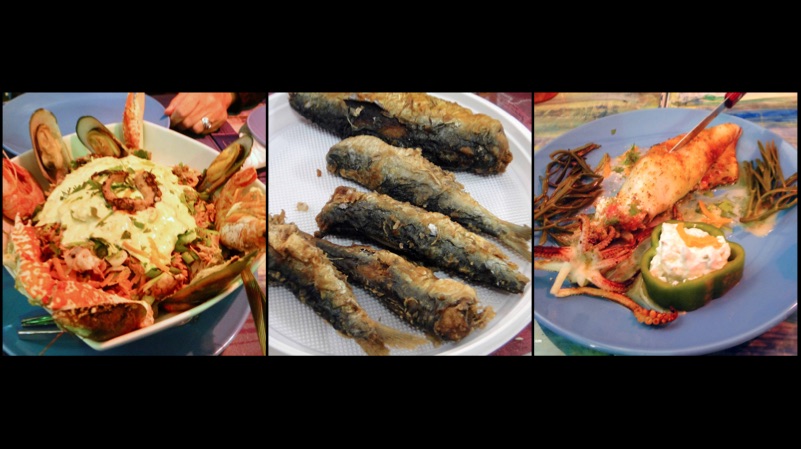
Greek society is all about family. So naturally Anna’s Taverna is a family affair. Anna Tsakkos is the chef; Mike’s her father, who among other tasks painted the tables, and Pantelis, her brother, is the amiable front of the house. The compact restaurant at water’s edge epitomizes a seamen’s tavern in its simplicity, and a Greek one in its colors and ambiance.
Yet Anna’s Taverna is in the 21st century. Chef Anna’s presentations are stylish, her recipes subtly sophisticated while maintaining that fresh-from-the-dock taste.
- fish soup tangy and thick as a chowder spiked with lemon and olive oil.
- seafood salad was a stunning presentation of ultra fresh octopus, crab legs, shrimp, tuna and mussels. The mussels and shrimp were jumbo!
- stuffed calamari with a light feta and tomato sauce.
- seafood pasta was another stunning presentation
- Loukoumades (of the gods): Anna’s are the finest I’ve ever had on many trips to Greece and many Loukoumades – one of the most ubiquitous of Greek pastries. Anna’s are lightly crisp, airy puff pastry napped with the island’s prized honey
Azul Wine Bar

There is a stunning panoramic view of the Aegean from street level. A colorful staircase descends to a postcard Greek seaside house with elements of Arts and Crafts architecture. Inside warm earth colors are punctuated with a riot of color from paintings, sculpture and fabric. Some among the amiable clientele play chess, read or sit at the handcrafted bar or on the deck (top sunset location).
Azul Wine Bar does actually serve food. It’s just that its owner, Ioanna Thanasiou, is an accomplished artist as well as a chef and business owner. This was her grandparents’ beach cottage, so why not keep its atmosphere homelike; it makes you want to stay.
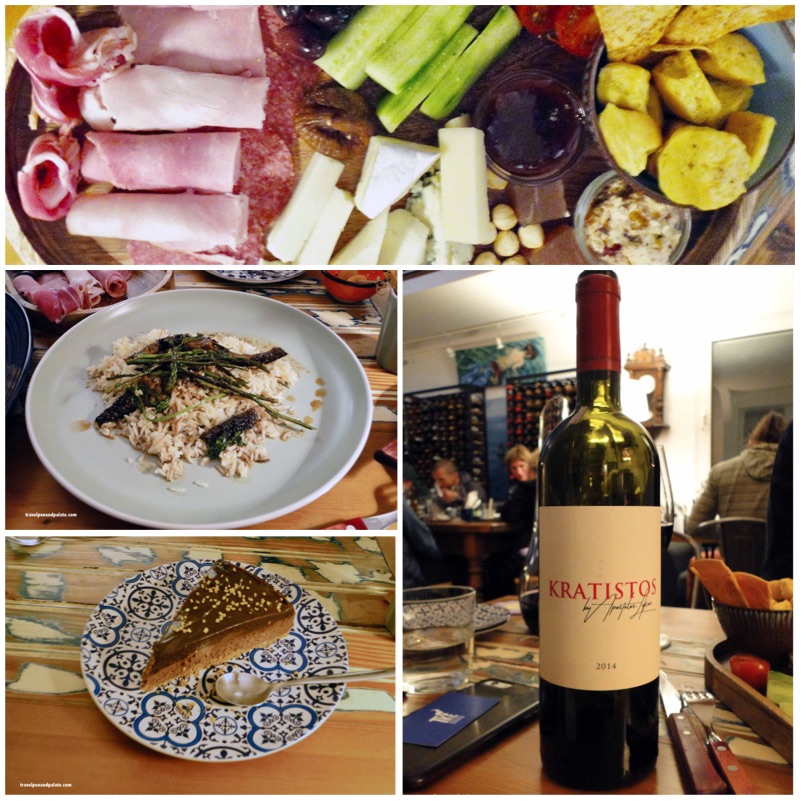
Azul’s menu is eclectic certainly appealing to the athletic clientel that flock to the adventure tourism Kalymnos offers. Rock climbers, divers and sports fishermen tend to crave fresh, healthy ingredients served with creativity. Ioanna makes good use of the island’s traditional location within the Spice routes of the Eastern Mediterranean when creating her menu. (The “fresh, healthy and creative part” is…well… this is Greece).
- A French influenced charcuterie opened the meal
- Fattoush: the classic Middle Eastern chopped salad (you can see the mainland of Turkey from Kalymnos).
- Pilaf of wild asparagus and mushrooms influenced by the Pellon region of Greece. The mushrooms were steamed sautéed then finished in beer and honey.
- Desert: chocolate coffee caramel cheesecake.
- The wine list was select and the bartenders were true mixologist.
A special dinner at Myrties Boutique Apartments

Although Myrties Boutique Apartments does not normally have food service since their apartments provide well-appointed kitchens, Mrs. Maria Sarafoglou wanted me to have a dish that traces its origins to ancient days – Trahana.
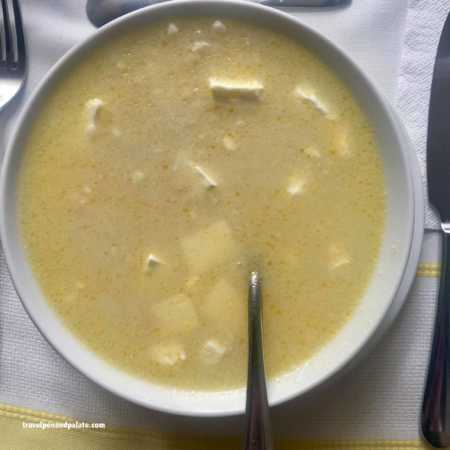
Some culinary historians consider trahana to be the world’s oldest convenience food – the Ramen Noodles of the ancient world. Trahana is made with semolina, wheat flour, bulgur or cracked wheat. Milk, buttermilk, or yogurt is mixed in to form thick dough. The mix is then broken into chunks, dried, and broken up again into pea size pieces before being dehydrated.
It sounds simple but the process, if done by hand, is lengthy so it was made in large quantities, carried in pouches on caravans and as a staple in households. Trahana comes in two types: sweet and sour. Sweet is made with whole milk, typically goat’s milk, and sour trahana is made with yogurt or buttermilk.
Trahana in various forms is still found almost everywhere from the Balkans to the Middle East and commercially produced (Agrozimi: makers of Greek traditional products). Another proof that Eastern Mediterranean/Mid Eastern cuisine knows no boundaries.
It’s a virtual instant thickener to soups and stews. Maria Sarafoglou created what she said was a “simple dish with ingredients on hand” but featuring the trahana as rice would be used in a risotto.

Maria Sarafoglou’s Trahana with mussels in ouzo
- Fresh mussels, grated onion, finely chopped garlic.
- Sautee onion in olive oil.
- Add mussels and ½ glass ouzo, some mustard, the garlic and fine herbs. Cover and steam gently a few minutes.
- Stir in some trahana to achieve the consistency of a risotto. (I will assume some broth and/or water would be added to maintain the risotto consistency for the minutes it takes for the trahana to rehydrate (follow trahana recipe or package directions). A garnish of feta and sour cream capped the flavor notes.
In Greek cuisine it was a formula ripe for infinite variations. For Kalymnos Island cuisine it was a classic fusion of ancient, earthy, fresh from the land and the sea. It’s food meant to be savored history et al.
When you go: Kalymnos in the Dodecanese Islands is served by both air and ferry service from Athens and its port, Piraeus. Schedules are seasonal so do check. It is usually possible to reach the Island year round through Kos Island by air or ferry and then Kalymnos by a short ferry ride.
Special Thanks: for facilitating my tour Kalymnos Association of Tourist Accommodation “Xenias,” Maria A. Sarafoglou, Fotini Tiliakou, Kalliopi Tsangari, Maria Helle Foy, Nikolaos Pelekanos, and Giannis Karamalis
Travel with Pen and Palate every month to Greece and the world in the Hellenic News of America.
